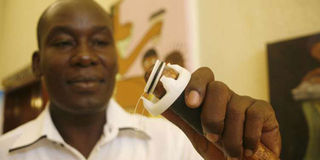Over 20,000 new HIV infections averted by Voluntary medical male circumcision

A man demonstrates how the PrePex device, an adult male circumcision tool works during a workshop on October 10, 2013. Ministry of health said PrePex has averted over 20,000 HIV infections since it was adopted eight years ago. PHOTO | PHOEBE OKALL | NATION MEDIA GROUP
What you need to know:
- PrePex involves the use of three rings, which are placed on the foreskin of a penis in turn creating pressure that stops blood flow to the region.
- Ministry of Health plans to use PrePex in Homa Bay, Kisumu, Siaya, Migori, Turkana, Kericho, West Pokot, Mombasa, Nakuru, and Nairobi.
Over 33, 000 new HIV infections have been averted in the past eight years as a result of the Voluntary Medical Male Circumcision.
Now the Health ministry says it will adopt the use of a non surgical device known as PrePex in the second phase of voluntary medical male circumcision (VMMC) programme .
The device will offer an alternative to surgical circumcision. The services will be offered free of charge in the next three years in “10 priority counties” where VMMC is being implemented.
The ten counties are Homa Bay, Kisumu, Siaya, Migori, Turkana, Kericho, West Pokot, Mombasa, Nakuru, and Nairobi (Kibera, Dagoretti, Huruma, and Mathare).
PrePex involves the use of three rings, which are placed on the foreskin of a penis in turn creating pressure that stops blood flow to the region.
This is done for about a week, after which the device and the foreskin are removed. It does not cause bleeding and neither are stitches nor anaesthesia required.
The process removes the retractable fold of tissue (foreskin) that covers the head of the penis.
The inner aspect of the foreskin is highly susceptible to HIV infections. Once circumcised, the tip becomes thicker thus HIV cannot penetrate.
Small tears or genital ulcers on the foreskin can increase HIV risk.
Head of VMMC at the Ministry of Health Dr Jacob Odhiambo said: “However, it does not mean that a man stops using a condom correctly and consistently to prevent from getting infected with the virus or other STIs.”
In addition, the men seeking the VMMC services will also get HIV testing and counselling as well as treatment for sexually transmitted infections.
“We will target 1 million men with the use of the PrePex alongside use of the normal conventional circumcision. We will target ages 13 and above,” said Dr Odhiambo.
He said trials are underway in Rwanda targeting smaller children and could be replicated in the country.
The VMMC programme in the country was launched in 2008 by the Ministry of Health as part of HIV prevention tools.
The normal male circumcision costs between Sh5,000 and Sh7,500 but the PrePex device costs about Sh1,200, an expense borne by the ministry.
Dr Odhiambo said even if Kenya stopped providing VMMC services today, “the circumcisions already done would continue to significantly reduce risk of HIV infection to individuals and effectively reduce the number of new infections with time.”
VMMC by averting new HIV infections, reduces the number of people needing HIV treatment and care. The World Health Organisation estimates that US$16.5 billion could be saved in HIV treatment and care costs by 2025.
A wound through the conventional surgical circumcision is stitched and healing occurs within six weeks, after which men ought to abstain for 42 days after the procedure.
In PrePex, the wound is allowed to close naturally and tends to take longer than with surgical procedures.
Thus, according to studies, it may mean that more men will resume sexual activity before complete healing and incur increased risks of HIV or sexually transmitted infection.
There are at least 100,000 new HIV infections annually with an estimated 1.6 million people living with the virus among them at least 191, 840 children.
In 2013, there were 58,465 people who died from HIV-related illnesses.
(Edited by Joel Muinde)



